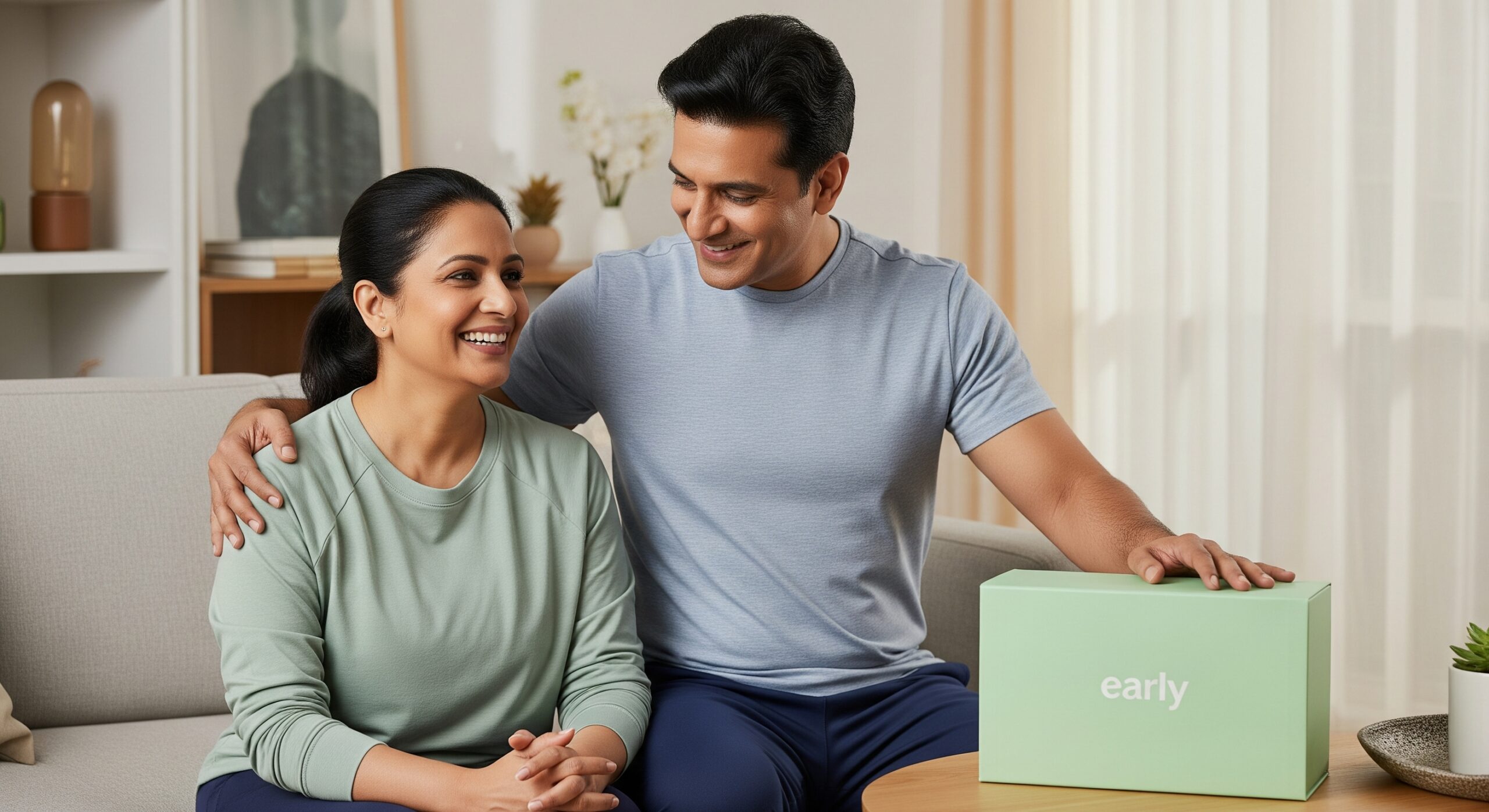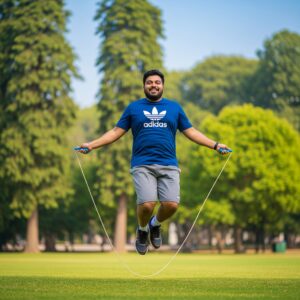GLP-1 Medications for Weight Loss in India: First 30 Days Guide
- June 18, 2025
- 2:11 pm
In this blog
What is GLP-1 and how does it work?
Week-by-Week breakdown
Tips and lessons from real users
The EARLY Perspective
Conclusion
About the Author
References
Ready to lose weight for good?
The last few years have seen a surge of interest in GLP-1 medications (like semaglutide and tirzepatide) for weight loss and metabolic health in India. With over 80 million Indians classified as obese and 225 million overweight, doctors and patients are eager for new solutions.
Even though the latest GLP-1 injectables (Ozempic, Wegovy, Mounjaro) weren’t widely available here until very recently, specialists report that more than half of their bariatric patients now ask about these obesity drugs. For example, a Times of India report noted a strong buzz: patients were excited about GLP-1 shots and some had even sourced pills like Rybelsus overseas.
Real stories are emerging – e.g., a young man in West Bengal lost 24 kg on Rybelsus and was able to stop his blood-pressure and cholesterol medications after continuing regular exercise. In this article we’ll explain what GLP-1 drugs do and also break down what to expect week-by-week during the first month (weeks 1–4) of therapy. We’ll also cover India-specific brands, costs, and practical tips (diet, hydration, exercise) to make the most of treatment while staying healthy. Ultimately, the first month is about adapting safely – not expecting perfection immediately.
What is GLP-1 and how does it work?
GLP-1 stands for glucagon-like peptide-1, a natural hormone produced in your gut after eating. It signals the brain to release insulin and tells you to stop eating. GLP-1 receptor agonist drugs (semaglutide, liraglutide, tirzepatide, etc.) mimic this hormone. They boost insulin, suppress glucagon, slow stomach emptying, and increase feelings of fullness after a meal. In other words, a GLP-1 drug makes you feel full sooner and keeps blood sugar more stable. As Reuters explains, “Wegovy and Ozempic (semaglutide) and Mounjaro… belong to a class of therapies known as GLP-1 receptor agonists that help control blood sugar and slow digestion, making people feel fuller for longer”. The end result is reduced hunger, smaller meals, and gradual weight loss (along with better blood sugar control for diabetics).
Week-by-week breakdown
Week 1: Your provider will usually start you on a low dose. In week 1, you may not see a big change on the scale, as your body is just beginning to adjust. Common reactions include mild nausea, fatigue or stomach discomfort. This is normal as your gut slows down digestion. Appetite may dip slightly, but it can take more time.
Week 2: By the second week, many people notice they feel fuller faster. Snacks may be less appealing and portion sizes naturally shrink. This is a sign the drug is taking effect. You still may not see huge weight loss yet, often the initial drop is mostly water weight (1–2 kg is common) as your body adjusts. Most of the Week 1 side effects (like nausea) start to ease off by now. However, some digestive changes (mild constipation or diarrhea) can linger.
Week 3: In week 3 the hunger-fighting effects often become more noticeable. You’ll likely find it easier to stick to smaller portions or avoid extra snacks. For many, gradual weight loss begins around this time (amount varies by person). At the same time, energy levels usually start to rebound as blood sugar steadies. Most of the common side effects have significantly diminished by now, though a few people might still experience mild gastric issues.
Week 4: By the end of the first month, you’ll have a clearer picture of how you’re doing. Most people now see measurable weight loss and reduced cravings. On average, clinical trials show about a 2% drop in body weight by week 4 of semaglutide therapy. For example, if you weighed 100 kg, that could mean ~2 kg lost; heavier individuals often lose a bit more. In practice, many patients report losing 2–5 kg in the first month, depending on dose and starting weight. Physically, your clothes may feel looser and you’ll notice more stable energy and better blood sugar readings. Most GI side effects have usually disappeared by week 4
Tips and lessons from real users
Indian patients on GLP-1 therapies share these practical tips to smooth the journey:
• Hydrate, hydrate, hydrate: Drink plenty of water, coconut water or buttermilk. Good hydration helps flush out ketones (from rapid fat burn) and eases nausea.
• Eat small, frequent meals: Opt for Indian-style small plates. For instance, a breakfast of khichdi or upma, a light dal-roti lunch, and a dinner of soup or steamed veggies can work well. Eat when you are hungry and stop before you’re stuffed. Eating slowly and chewing well helps your GLP-1 drug signal fullness to the brain.
• Focus on fiber and protein: Include plenty of lentils, legumes, vegetables, and whole grains. These high-fiber foods keep you full and support gut health. Also add protein at every meal (chicken, dal, paneer, eggs or tofu) to prevent muscle loss and further curb appetite.
• Avoid fatty/spicy foods initially: GLP-1 side effects can worsen with rich, greasy or very spicy dishes. Stick to lighter Indian cooking (use less oil, opt for grilled or steamed items) until your body fully adjusts.
• Start gentle exercise: Incorporate walking, yoga or light aerobic activity. Even daily 20–30 minute walks can boost your mood, aid digestion, and enhance weight loss. As Week 2 tips suggest, a little exercise improves wellness without overstressing your system.
• Mind your mind: GLP-1 meds can change your hunger hormones, which is a lot to adapt to mentally. Keep realistic expectations (e.g. 0.5–1 kg per week is a healthy pace) and track non-scale successes (better sleep, clearer skin, more energy). Consider journaling feelings or joining a support group to stay motivated.
• Listen to your body: If nausea hits, try bland foods (curd rice, buttermilk) or over-the-counter remedies. If symptoms are severe or persistent, consult your doctor right away.
• Learn from others: Many Indian users find it helpful to consult forums or talk to someone who’s on GLP-1s. One user (Arjun) who lost 24 kg on Rybelsus emphasizes that after weight loss, he maintained health by regular exercise and diet, eventually stopping his BP and cholesterol meds. His lesson: the drug jumpstarts weight loss, but sustainable habits carry it forward.
The Early perspective
At Early, we see GLP-1 therapy as a complement to our holistic approach. We focus onencourage you to set realistic goals: the first month is about adapting, not perfection. Celebrate the small wins – a lower blood sugar reading, fewer cravings, or simply feeling more in control of meals. Track your meals, moods and side effects, and share this with your coach or doctor.
Our coaches advise: focus on building consistency. If a weekend celebration causes slight nausea, don’t view it as failure; just return to your routine. Plan ahead (carry healthy snacks if you know you’ll be busy). Use our workout plans (walks, home cardio or yoga) that fit your daily schedule. Keep hydration (notice any increase in thirst or urination as the GLP-1 kicks in and removes excess sugar/water from the body).
Finally, maintain an open dialogue with healthcare providers. Adjust your diet gradually – for instance, try swapping one heavy meal each day for a wholesome thali with brown rice and veggies, or replacing sugar in tea with small amounts of stevia or jaggery. And remember, Early is here to support every step – from meal ideas to motivation to doctor consultation tips.
Conclusion
The first 30 days on a GLP-1 therapy are all about adaptation and learning. You may not become perfect at every healthy habit overnight, but each week you should feel progressively better and see positive changes. Keep in mind that weight loss is not linear – some days you’ll lose a lot, other days not much. The key is staying consistent with your small-meal, high-fiber Indian diet and staying active, while the GLP-1 medication works quietly in the background. Over a month you’ll likely feel fewer cravings and notice lighter clothes and better health numbers, even if the scale moves only a few kilos. Early reminds you: this journey is a marathon, not a sprint. Use these first four weeks to find what works for you (like which foods settle best, what exercise you enjoy) and build those habits. With medical guidance, patience, and the right mindset, GLP-1 therapy can jumpstart a healthier lifestyle – one week, one meal, and one step at a time.

About the Author
WRISHILA PAL
Currently building all things brand, buzz, and bottom line from the Founder’s Office at a stealth-mode healthtech startup. From strategy decks to story-driven content to full-funnel experiments, she gets her hands dirty across it all (sometimes with post-its, sometimes with pixels).
References
1. Effectiveness of an App and Provider Counseling for Obesity Treatment in Primary Care
https://www.ncbi.nlm.nih.gov/pmc
/articles/PMC6388618/
2. Accuracy of Smart Scales on Weight and Body Composition: Observational Study
https://www.ncbi.nlm.nih.gov/pmc/
articles/PMC8122302/
3. The efficacy of a daily self-weighing weight loss intervention using smart scales and email
https://www.ncbi.nlm.nih.gov/
pmc/articles/PMC3788086/
4. The clinical importance of visceral adiposity: a critical review of methods for visceral
adipose tissue analysis
https://www.ncbi.nlm.nih.gov/pmc
/articles/PMC3473928/
In this blog
What is GLP-1 and how does it work?
Week-by-Week breakdown
Tips and lessons from real users
The EARLY Perspective
Conclusion
About the Author
References



